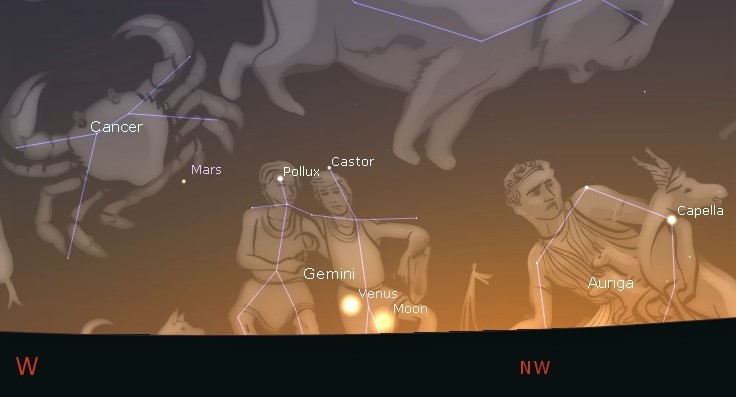This Week’s Sky at a Glance, 2021 June 5 – 17 ~by Curt Nason
The astronomical highlight for New Brunswick this week is a partial solar eclipse on Thursday morning at sunrise, from 5:38 to 7:38. At the peak, around 6:36, approximately 75% of the Sun’s surface area will be covered by the Moon. This is our best solar eclipse since August 11, 1999, when more than 90% of the Sun was covered.
Solar eclipses occur at new Moon, but since the lunar orbit is tilted to Earth’s orbit by five degrees (ten times the Moon’s apparent diameter) it is usually above or below the Sun at that phase. For a period of a few weeks, twice a year, new Moon occurs when it is near to crossing Earth’s orbit and there will be a partial, annular or total eclipse somewhere on the planet. With a total eclipse, a rarity at any one location, the Moon’s shadow races across part of Earth on a path 100 to 200 kilometres wide. Locations outside of the shadow get a partial eclipse, with percent coverage decreasing with distance. An annular eclipse, which this one will be in northern Ontario and Quebec, occurs when the Moon is near apogee and its apparent width is smaller than that of the Sun.
Staring at the Sun without proper eye protection can cause permanent eye damage, even blindness, and since the eye has no pain receptors you may not notice any damage for several hours. Proper protection is #14 welder’s glass or approved eclipse viewers / glasses from a reputable dealer. Note that these are not safe for use with binoculars and telescopes; other filters can be purchased for this purpose. A cheap and effective way to view the partial eclipse is to project the sunlight through a pinhole onto a white surface. Check the Internet for methods of doing this. Or, use Nature’s projection method by looking at the shadows of leaves, which often have tiny holes to project the Sun’s image.
This Week in the Solar System
Saturday’s sunrise in Moncton is at 5:29 am and sunset will occur at 9:06 pm, giving 15 hours, 37 minutes of daylight (5:37 am and 9:08 pm in Saint John). Next Saturday the Sun will rise at 5:27 am and set at 9:10 pm, giving 15 hours, 43 minutes of daylight (5:35 am and 9:12 pm in Saint John).
The Moon is new early Thursday morning, passing across much of the Sun over two hours as they rise. The slim crescent will be within a binocular view to the lower right of Venus on Friday evening. Mercury is setting with the Sun early in the week, and it is at inferior conjunction on Thursday. Mars’s eastward motion against the stars brings it in line with the Gemini Twins on Tuesday. Saturn and Jupiter are well placed for observing for nighthawks or very early risers, and by late in the month the two gas giants will be rising before midnight.
With astronomy meetings and outreach activities on hold, you can watch the local Sunday Night Astronomy Show at 8 pm and view archived shows.
Questions? Contact Curt Nason.

